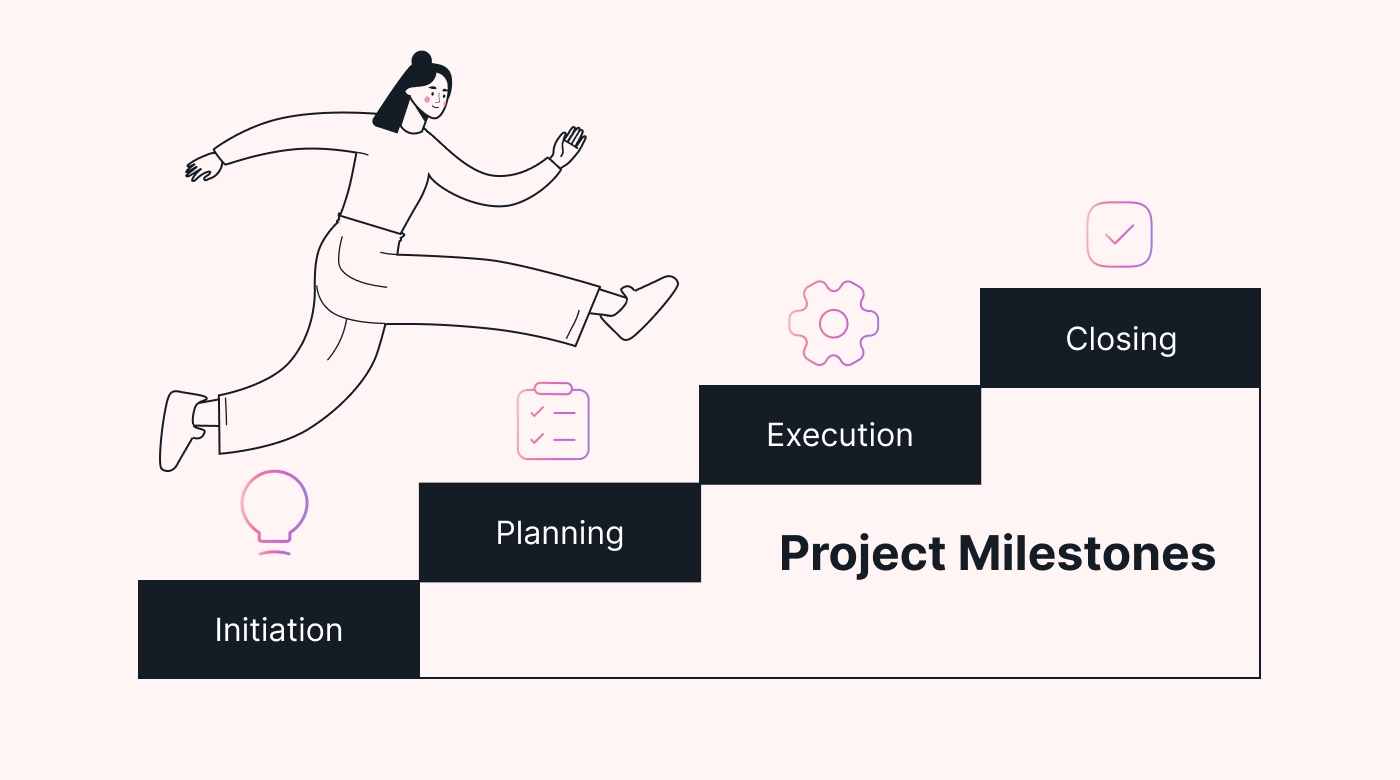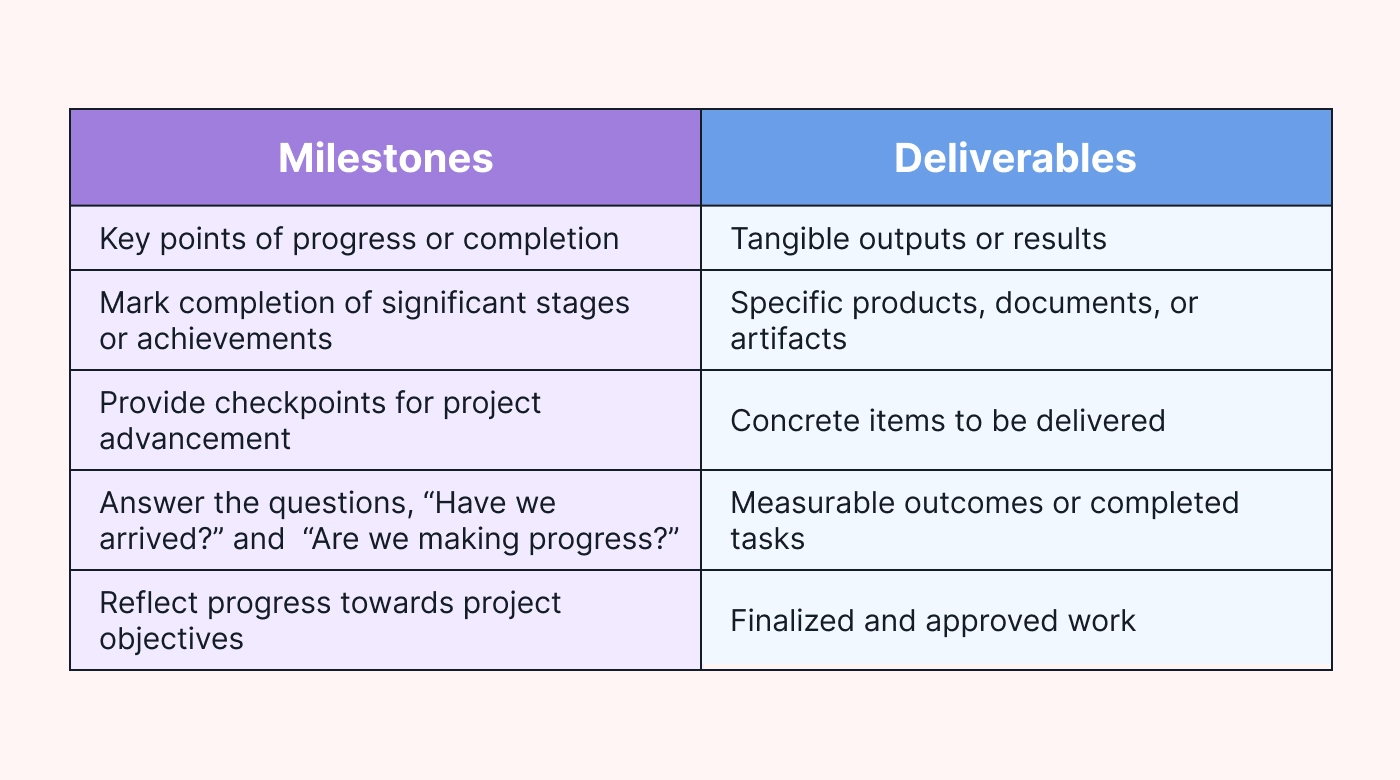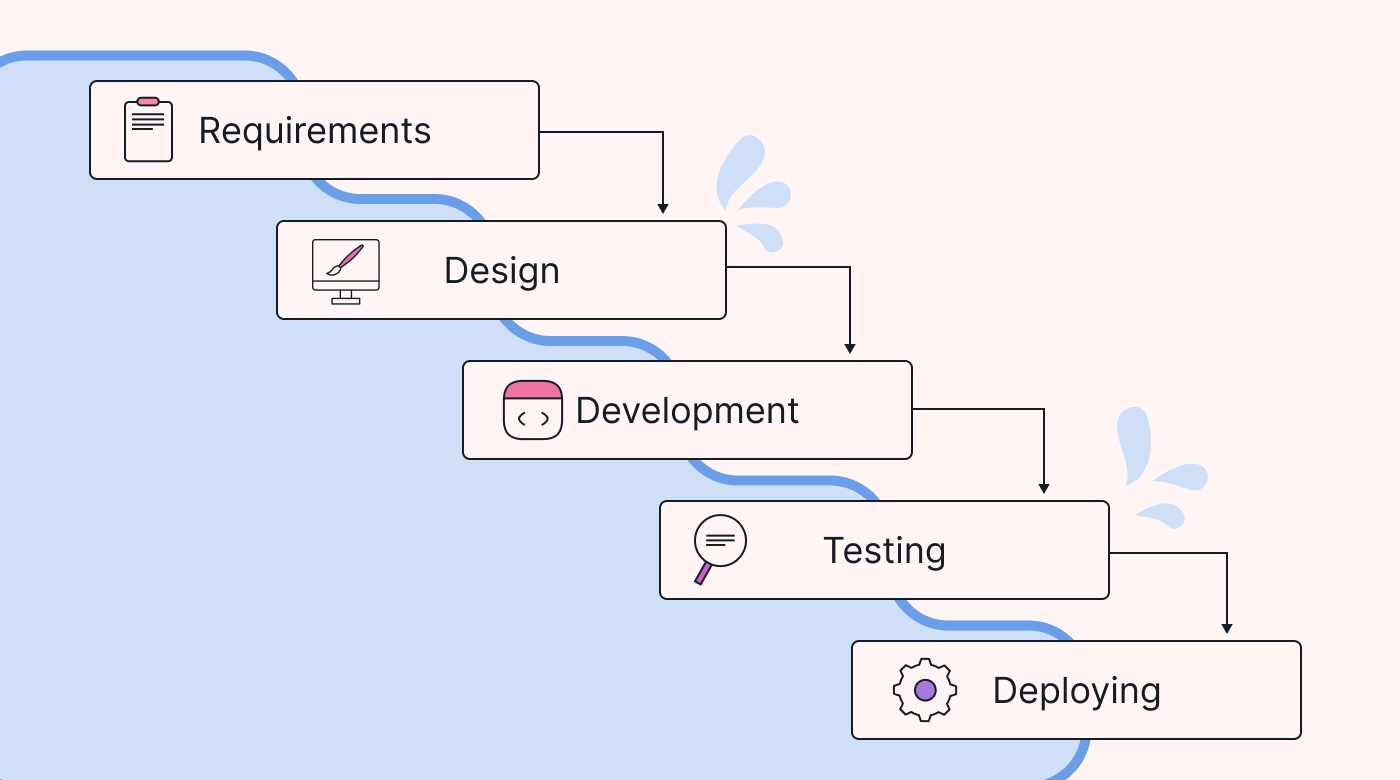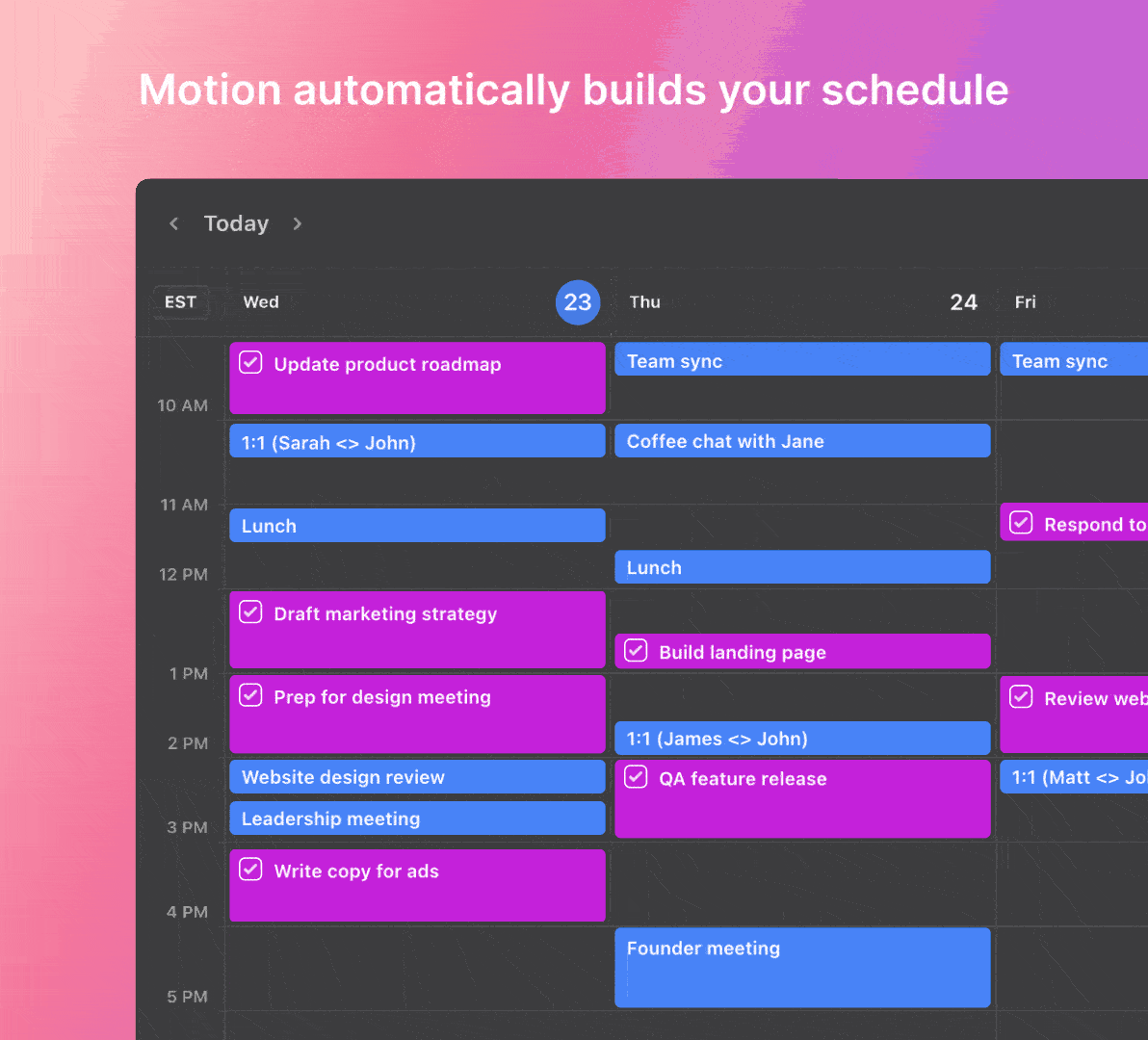Picture wandering around a place you've never been to with no map, unsure of how far you've come, and feeling totally lost. It’s disorienting, isn’t it?
Well, projects are no different. They require clear milestones to guide you, mark your progress, and ensure success.
In this post, we unravel the concept of project milestones’ importance in professional project plans and management. We will go over how they differ from goals and deliverables, how to write them, and some examples. Milestones are markers for project progress and opportunities for “wins” along the way.
What are project milestones?
Project management milestones are planned checkpoints from the project planning phase that signify the completion of a major deliverable or stage. They’re critical as they help project managers gauge how well a project is moving along.

Project milestones depend on a group of predecessor tasks required to build a deliverable, a major module of a deliverable, or the completion of a phase of the project.
For example, in a website development project, milestones might include the completion of key stages like:
- Milestone 1: The completion of the wireframe design
- Milestone 2: Finalization of website layout
- Milestone 3: Implementation of backend functionality
- Milestone 4: The grand launch of the website itself
However, it's also important to note that milestones can become potential pressure points. If a milestone isn't met as planned, it may indicate issues or delays in the project schedule. A failed milestone is also a red flag, highlighting the need to assess existing processes and make changes to get the team back on track.
How are project milestones different from project goals, deliverables, and phases?
People often use project milestones, goals, and phases interchangeably. However, these three terms refer to different concepts. Let’s take a look:
Project milestones vs project goals
Project milestones help team members and key stakeholders know what's expected of them. They also act as yardsticks for measuring project progress.
That said, they're different from project goals, which define what a project is supposed to achieve.
Project milestones and goals aren’t mutually exclusive.
Suppose one project goal for a marketing campaign is to increase sales. Project milestones might include converting three new clients or upselling to existing clients. In that case, reaching each sales milestone will coincide with the team achieving its sales goal.
Project deliverables vs project milestones
A project's deliverables are the specific things a team should create out of the project itself, as they're connected to the project’s tasks and activities. They can be measured to see if they're good. One way to check is to get feedback from those who will use them.
Milestones show progress in a more personal way, but they also become measurable when they're connected to specific goals.
Here’s an overview of how milestones compare to project deliverables:

When a product has been handed over to the client, for example, that's a clear milestone. The project team can achieve this milestone when they deliver the project outcome to the client.
Project milestones vs project stages
Project milestones provide clear checkpoints, signaling that the project team has completed a specific set of tasks. An example is the gates in the stage-gate process. Each gate is a milestone that shows the previous stage is complete.
Project stages can overlap or interact with each other, and there might be interdependencies between them. For instance, in the Scrum framework, a project team may go back and forth through different stages, and a major milestone could be completing the team’s first sprint.
Project milestone examples
To help you determine what to use for your project milestones, we’ve put together examples from construction and software and app development.
Examples of project milestones in the construction industry
In construction, common project milestone examples include:
- Design creation
- Client approval
- Site acquisition
- Finalizing supplier contracts
Let's take a look at what the milestones might be in a traditional project life cycle in the construction industry. In this example, we'll examine a building project for a tower.
Initiation phase
Milestone 1: Completion of a comprehensive feasibility study, including contingency plans
Milestone 2: Obtaining the necessary permits and regulatory approvals for construction
Milestone 3: Finalization of project budget with funding sources secured
Planning phase
Milestone 4: Approval of detailed architectural and engineering plans with the client
Milestone 5: Completion of resource planning for equipment, materials, and project teams
Execution phase
Milestone 6: Completing the foundation construction (also a critical task)
Milestone 7: Successful completion of the structural framework
Milestone 8: Completion of plumbing and electrical installations
Milestone 9: Completing the structure, including walls, roof, and windows
Closing phase
Milestone 10: Final inspection and obtaining the occupancy permit
Milestone 11: Hand over the completed building to the client on 10 August 2023
Examples of project milestones for software development
For dev teams, project milestones are related to the key steps in the development process, such as:
- Requirements gathering
- Solution design and project scope
- Pre-development planning
- Development
- Quality assurance testing
- Deployment
Next, let’s use a software development project that uses the waterfall methodology lifecycle to break down the potential milestones a team might use.

Requirements gathering phase
Milestone 1: Completion of stakeholder requirements survey
Milestone 2: Completion of client requirements acceptance review
Design phase
Milestone 3: Completion of high-level architecture
Milestone 4: Detailed design review completion
Implementation phase
Milestone 5: Coding and unit test complete for Module A
Milestone 6: Coding and unit test complete for Module B
Testing phase
Milestone 7: Integration test complete
Milestone 8: User acceptance test complete
Deployment phase
Milestone 9: User training complete
Milestone 10: Launch complete
Example of project milestones for an Agile Scrum sprint lifecycle
Let's delve into the various phases of the development process in an Agile Scrum sprint lifecycle.
Sprint 1
Milestone 1: Completion of sprint planning
Milestone 2: Completion of sprint backlog
Milestone 3: Completion of sprint review with customer
Milestone 4: Completion of sprint retrospective
How to identify key milestones in a project
Identifying key milestones does not have to be difficult.
Thoroughly examine the project's goals and objectives. Understanding the desired outcomes will help you find milestones that mark progress toward the mission.
Engage your project team and stakeholders in the milestone identification process. Their diverse perspectives and expertise will provide valuable insights into the identified milestones. They can also show any you have missed, and it helps align expectations regarding the milestones.
Consider the relationships between tasks, project constraints, and key deliverables. To do this, analyze task dependencies, assess project constraints, and identify key project deliverables that significantly impact project progress.
Look for points in the project where significant tasks are completed, deliverables are achieved, and project phases are completed. These are clear indicators of possible milestones.
How to write a project milestone
Writing milestones helps guide everyone involved, so it’s important to know how to create clear milestones.
Be specific
Use straightforward language to describe the milestone and avoid unnecessary jargon. Clearly outline the expected outcome, including deliverables or tasks linked with the milestone. This clarity ensures that all project stakeholders understand the milestone’s significance and purpose.

Examples of detailed project milestones:
- “Testing milestone: Completed wireframes, design mockups, and interactive prototypes for review”
- “Development milestone: Implemented core functionality and with verified unit testing for key features.”
- “Marketing milestone: Launched targeted advertising campaigns on social media platforms with metrics on the initial engagement.”
Set realistic timelines
Next up, let’s take a look at milestones that mention timelines so you know what detail to include:
- “The design phase milestone is completed once all the design phase prototypes have been approved.”
- “The development milestone is achieved when the first production unit is complete.”
- “The marketing milestone is achieved when we bring in 15,000 organic online customers.”
Top tip:
You can use milestones to create a realistic project timeline of all the tasks and work that lead up to its completion. If you start with your targeted milestone date and work backward, you can assess whether your milestone completion date is reasonable, based on dependencies and accurate timeline estimates.
Or, working forward, you can use the design phase milestone as a marker and look at all the work leading up to it to determine when it can be completed.
Tips to help make the most out of project milestones
Once you create milestones for your project, you’re not done yet.
Review and update milestones regularly
Some project milestones are dynamic and need to change as the project progresses.
Milestones may also change in response to external factors. An example is when regulatory bodies pass new compliance requirements. The project team may add new milestones to reflect these changes.
Businesses should review and update their milestones regularly. This ensures that milestones remain practical and aligned with the project's evolving needs and circumstances.
Celebrate achievements
Project teams should celebrate every milestone they reach, as this boosts morale and is a great motivator.
Reaching a milestone also builds a sense of accomplishment. It serves as a reminder of the progress made and helps keep the momentum going.
Efficient milestone management with Motion
Motion, an AI-powered project management tool, is changing how project managers handle projects.

Project milestones depend on the completion of a set of other tasks that together deliver a valuable piece of the project. Motion allows you to establish task dependencies to make sure that tasks progress in a logical sequence. Using this, you can avoid possible delays or bottlenecks and confidently hit milestone targets.
Embrace the future of milestone tracking and management with Motion.
Sign up for your 7-day free trial today.

Hailing from South Africa, Richard Reynolds is a seasoned project & product management writer at large (last sighted in Vietnam!) With 5+ years experience in the field, a BA in Psychology, and education in Biz Mgmt & Professional Project Management, Richard remains passionate about simplifying complex project concepts with seasoned professionals and newbies alike.




